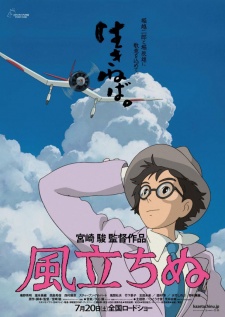
Twenty-seven years after the simultaneous release of Miyazaki Hayao’s children’s tale My Neighbor Totoro and Takahata Isao’s World War II tragedy Grave of the Fireflies, the two switch roles for their final films in their thirty year partnership at Studio Ghibli, with Takahata taking the lighthearted classic Japanese folktale The Tale of Princess Kaguya and Miyazaki finally letting his lifelong dreams soar in the historical war epic of engineering, love, and the brevity of life that is The Wind Rises. From casting his closest friend Anno Hideaki as the voice of the famed aeronautical engineer and protagonist Horikoshi Jiro to the painstakingly researched yet dreamlike plane designs, there's never any doubt that Miyazaki is letting his inner passion for history and aeronautics run wild. What it lacks is the real magic of Miyazaki’s fantasy works, which have become his trademark after all these years, but in the last moments of his career he showed a maturity at peeking at that same wonder through the eyes of history, and the characters who wrote it.
Yet for a movie with a relaxed pace, The Wind Rises covers a lot of ground, following Jiro from his days as a kid dreaming about the future of planes to a college student eating mackerel and running numbers on a slide rule, on to his job at Mitsubishi and watching as the planes he designed disintegrated into scrap in spectacular fashion, and to the trip to the Japanese countryside where he found a fated, innocent, doomed love, along with the inspiration and support to finally achieve his dream and move Japan onto the international scene as the reality of World War II slowly loomed over the country, over his conscience as an artist. This is Jiro’s film first, a film about engineering second, a story of love third, and a heartwarming series of very comical, very human interactions at its base. While I had unfortunate issues with the monotonic voice he was given by Anno, which was amusing knowing the history between Anno and Miyazaki but overall served to degrade Jiro’s emotions as a human character, Jiro himself was a fun, introspective fellow with clear passion and intellect. Between the outside world he interacts with and the inside world he molds we get a fun, informative experience of pre-WWII Japan and their push to grow past the rest of modern civilization.
The other central character is his fiancé Naoko, who appears into the story very late and is on screen very little, but nevertheless serves as a counterpoint to the driving technological progress of Jiro’s work instead of just as a foil for his accomplishments. Here is where Miyazaki’s years of maturation show through, with his use of simple, frank dialogue that conveys true closeness, tenderness, and understanding between the two without ever becoming dramatic or stilted. Jiro is under pressure to produce advanced planes in the shadow of both his failures and his knowledge that his art will be used for war; Naoko has tuberculosis and lives every day face to face with death, and the knowledge that she and Jiro will be apart yet again. Their scenes are quiet episodes of internal conflict, interspersed with choice moments in time where they finally are allowed to forget their world, both inside and out. We too get to relax as the camera lingers, although maybe the camera lingers a little too long at times to mesh naturally with the driving narrative. In contrast, when her time finally comes in the midst of Jiro’s final triumph, there is barely any time or attention the camera has to spare, which only makes her passing that much harder to swallow.
For in the end it all comes back to Jiro, from the bittersweet end to their short time together to the continued work he shares with the multitude of amusing side characters to the very mechanics of the film—the artwork and pacing and use of music and silence—which impart what it was like to be him, or at least Miyazaki’s idyllic version of him. The questions of technology and war, a longtime question posed by Miyazaki’s early works, are finally brought directly into the dialogue of The Wind Rises, and though he has no moral solution to impart, he does have his own answer to give in an unshakably certain voice. Knowing him as a legendary writer of fantasy, and seeing how this movie represents a culmination of his style, his dilemmas, and his lifelong passions, even its weaknesses are more quintessentially representative of Miyazaki than any of his works up until now, though it pains me to say in the face of his treasures from the last thirty years. One could even say it is more a representative of the director himself than of his desire to make a movie for us. The Wind Rises’ notoriety as his swan song will eventually fade, and with it will most popular desire to watch it, on the basis that as a historical drama it does not represent a true Miyazaki work as we know it. But after watching it, it's not hard to imagine a world where stories grounded in reality were what made him loved around the world.